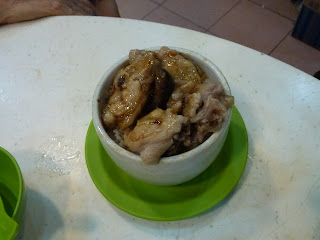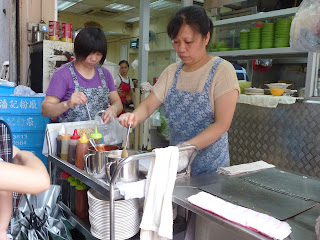鴻記 again. They serve dim sum too:
 |
| Derek Ou's obligatory har gow (蝦餃) and siu mai (燒賣) shot. |
 |
| Chicken and mushrooms on rice with sweet soy sauce (冬菇雞飯) |
 |
| for DOP, of course. |
Today, we went to Sham Shui Po (深水埗), at the northwestern edge of Kowloon. Its name literally translates to "Deep Water Pier". Some shots from the bus there:
 |
| The valley at the back of Sham Tseng. |
 |
| On Tsuen Wan Road, HK Route 5. The Nina Tower is visible to the left. It's 20m taller than First Canadian Place (the tallest building in Toronto). |
 |
| The island of Tsing Yi across Rambler Channel (藍巴勒海峽). |
 |
| Leaving Route 5, we reach Cheung Sha Wan Road (長沙灣道). |
 |
| The Kowloon Technical School (九龍工業學校), typical secondary school architecture in the city. |
It's a rather large mall, with nine floors and a skating rink on the top level:
That roller coaster there has been defunct for years.
Inside the mall, we stop for a look around a shop that specializes in selling bird's nest (燕窩), a luxury good made from the saliva proteins of cave swifts that is traditionally thought to have medicinal properties.
Now, you wouldn't be able to tell from the mall, but Sham Shui Po is the poorest district in Hong Kong:
Many of the buildings are old and decrepit, and the streets and signs are not as well kept or easy to follow as they are in other,better parts of the city.
One of the great ironies of this city is that even in this poorest district, on every street there are shops selling pearl necklaces, diamonds, or other forms of jewellery, just like another part of the city. In addition, Sham Shui Po has gained a reputation for being the best place to purchase electronics in Hong Kong, and has many malls dedicated to selling computer parts and accessories.
So why did we come here? Like always, apparently there are good eats:
合益泰小食 here specializes a special variety of rice noodle rolls that are known as "street-side cheung fun" (街邊腸粉).
 |
| Here they are making it, streetside, of course. |
Well, taste-wise, there's nothing special about them, but they were easily the smoothest and silkiest cheung fun I've ever had.
Next, to Lau Sum Kee (劉森記麵家 [read right to left below]), which apparently was the subject of many celebrity endorsements, hence all the photos on the walls...
Known for their shrimp roe lo mein (蝦子撈麵), Lau Sum Kee apparently makes their noodles the traditional way, by pressing the dough using a stalk of bamboo.
Now, if you guys have been to any American/Canadian-Chinese restaurant, I know what you're thinking. "This isn't lo mein!" Real lo mein (撈麵) is made using the same thin noodles as wonton noodles, and at its most basic is a dish of noodles ("mein" 麵) with soup on the side, which you then dip (or mix, "lo" 撈) the noodles in. In North America, early immigrants who couldn't stir fry their noodles too well ("chow mein" 炒麵) either deep-fried them to create the crispy chow mein common in American-Chinese, or simply mixed a stir-fry sauce in with steamed or boiled noodles, hence "lo mein".
This particular lo mein is topped with shrimp roe, as the name suggests, which lends a crunchiness and seafood flavour. The noodles were nothing special, though.
Finally, for dessert, we went to Kong Wo Dou Bun Chong (公和荳品廠), which specializes in making soy products.
The tofu on the right there is sold the traditional way, straight off the boards on which it was made.
We order a plate of fried tofu snacks and glasses of soy milk (豆漿):
Before ordering the tofu dessert (豆花):
Usually, tofu is completely tasteless, but here, the tofu being freshly made, I could taste the soybeans inside of it. A really interesting taste experience.
Which sells desserts and snacks. We get a few put chai ko (砵仔糕), a pastry made from glutinous rice flour and azuki or red beans (紅豆).
We hop on the subway back to Tsuen Wan:
And catch a bus back home.
For dinner, we head out with some friends to the local "serious" Chinese restaurant, or 酒樓 (literally "wine building").
Being in Sham Tseng, we obviously have some roast goose, along with some various other Cantonese specialities (which I can't even name!)
 |
| Not the best in town! |

























No comments:
Post a Comment